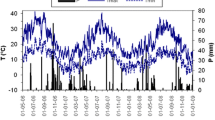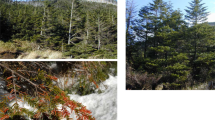Abstract
Leaf gas exchange and stem xylem hydraulic and mechanical properties were studied for unburned adults and resprouting burned Juglans californica (southern California black walnut) trees 1 year after a fire to explore possible trade-offs between mechanical and hydraulic properties of plants. The CO2 uptake rates and stomatal conductance were 2–3 times greater for resprouting trees than for unburned adults. Both predawn and midday water potentials were more negative for unburned adult trees, indicating that the stems were experiencing greater water stress than the stems of resprouting trees. In addition, the xylem specific conductivity was similar in the two growth forms, even though the stems of resprouting trees were less vulnerable to water-stress-induced embolism than similar diameter, but older, stems of adult trees. The reduced vulnerability may have been due to less cavitation fatigue in stems of resprouts. The modulus of elasticity, modulus of rupture and xylem density were all greater for resprouts, indicating that resprouts have greater mechanical strength than do adult trees. The data suggest that there is no trade-off between stem mechanical strength and shoot hydraulic and photosynthetic efficiency in resprouts, which may have implications for the success of this species in the fire-prone plant communities of southern California.





Similar content being viewed by others
References
Adamopoulos S, Voulgaridis E (2002) Within-tree variation in growth rate and cell dimensions in the wood of black locust (Robinia pseudoacacia). IAWA J 23:191–199
Alder N, Pockman WT, Sperry JS, Nuismer S (1997) Use of centrifugal force in the study of xylem cavitation. J Exp Bot 48:665–674
Bassow SL, Bazzaz FA (1997) Intra- and inter-specific variation in canopy photosynthesis in a mixed deciduous forest. Oecologia 109:507–515
Bonham VA, Barnett JR (2001) Fiber length and microfibril angle in silver birch (Betula pendula Roth). Holzforschung 55:159–162
Castell C, Trradas J, Tenhunen JD (1994) Water relations, gas exchange, and growth of resprouts and mature plant shoots of Arbutus unedo L. and Quercus ilex L. Oecologia 98:201–211
Christensen-Dalsgaard KK, Fournier M, Ennos AR, Barfod AS (2007) Changes in vessel anatomy in response to mechanical loading in six species of tropical trees. New Phytol 176:610–622
Cochard H, Coll L, Le Roux X, Améglio T (2002) Unraveling the effects of plant hydraulics on stomatal closure during water stress in walnut. Plant Physiol 128:282–290
Cochard H, Casella E, Mencuccini M (2007) Xylem vulnerability to cavitation varies among poplar and willow clones and correlates with yield. Tree Physiol 27:1761–1767
DeSouza J, Silka PA, Davis SD (1986) Comparative physiology of burned and unburned Rhus laurina after chaparral wildfire. Oecologia 71:63–68
Hacke UG, Sperry JS, Pockman WT, Davis SD, McCulloh KA (2001a) Trends in wood density and structure are linked to prevention of xylem implosion by negative pressure. Oecologia 126:457–461
Hacke UG, Stiller V, Sperry JS, Pittermann J, McCulloh KA (2001b) Cavitation fatigue. Embolism and refilling cycles can weaken the cavitation resistance of xylem. Plant Physiol 125:777–786
Honjo K, Furukawa I, Sahri MH (2005) Radial variation of fiber length increment in Acacia mangium. IAWA J 26:339–352
Ishida A, Yazaki K, Hoe AL (2005) Ontogenetic transition of leaf physiology and anatomy from seedlings to mature trees of a rain forest pioneer tree, Macaranga gigantea. Tree Physiol 25:513–522
Jacobsen AL, Ewers FW, Pratt RB, Paddock WA III, Davis SD (2005) Do xylem fibers affect vessel cavitation resistance? Plant Physiol 139:546–556
Jacobsen AL, Pratt RB, Ewers FW, Davis SD (2007a) Cavitation resistance among 26 chaparral species of southern California. Ecol Monogr 77:99–115
Jacobsen AL, Agenbag L, Esler KJ, Pratt RB, Ewers FW, Davis SD (2007b) Xylem density biomechanics and anatomical traits correlate with water stress in 17 evergreen shrubs species of the Mediterranean-type climate region of South Africa. J Ecol 95:171–183
Kavanagh KL, Bond BJ, Aitken SN, Gartner BL, Knowe S (1999) Shoot and root vulnerability to xylem cavitation in four populations of Douglas-fir seedlings. Tree Physiol 19:31–37
Keeley JE (1987) Role of fire in seed germination of woody taxa in California chaparral. Ecology 68:434–443
Keeley JE (1990) Demographic structure of California black walnut (Juglans californica; Juglandaceae) woodlands in southern California. Madroño 37:237–248
Kern KA, Ewers FW, Telewski FW, Koehler L (2005) Mechanical perturbation affects conductivity, mechanical properties and aboveground biomass of hybrid poplars. Tree Physiol 25:1243–1251
Mullally DP (1992) Distribution and environmental relations of California black walnut (Juglans californica) in the eastern Santa Susana Mountains, Los Angeles County. Crossosoma 18:1–17
Niklas KJ (1992) Plant biomechanics. University of Chicago Press, Chicago
Panshin AJ, De Zeeuw C (1980) Textbook of wood technology. McGraw-Hill, New York
Pratt RB, Jacobsen AL, Ewers FW, Davis SD (2007) Relationships among xylem transport, biomechanics and storage in stems and roots of nine Rhamnaceae species of the California chaparral. New Phytol 174:787–798
Quinn RD (1990) The status of walnut forests and woodlands (Juglans californica) in southern California. In: Schoenherr AA (ed) Endangered plant communities of southern California: proceedings of the 15th annual symposium. Southern California Botanists, Claremont, pp 42–45
Saito T, Tanaka T, Tanabe H, Matsumoto Y, Morikawa Y (2003) Variations in transpiration rate and leaf cell turgor maintenance in saplings of deciduous broad-leaved tree species common in cool temperate forests in Japan. Tree Physiol 23:59–66
Saruwatari MW, Davis SD (1989) Tissue water relations of three chaparral shrub species after wildfire. Oecologia 80:303–308
Schoenherr AA (1992) A natural history of California. University of California Press, Berkeley
Schwilk DW, Ackerly DD (2005) Is there a cost to resprouting? Seedling growth rate and drought tolerance in sprouting and nonsprouting Ceanothus (Rhamnaceae). Am J Bot 92:404–410
Sperry JS, Saliendra NZ (1994) Intra- and inter-plant variation in xylem cavitation in Betula occidentalis. Plant Cell Environ 17:1233–1241
Sperry JS, Donnelly JR, Tyree MT (1988a) A method of measuring hydraulic conductivity and embolism in xylem. Plant Cell Environ 11:35–40
Sperry JS, Tyree MT, Donnelly JR (1988b) Vulnerability of xylem to embolism in a mangrove vs. an inland species of Rhizophoraceae. Physiol Plant 74:276–283
Tenbrink VL, Quinn RD, Carlton GC (1999) Understory vegetation of a southern California black walnut (Juglans californica) woodland. Crossosoma 25:1–8
Thomas CM, Davis SD (1989) Recovery patterns of three chaparral shrub species after wildfire. Oecologia 80:309–320
Tyree MT, Dixon MA (1986) Water stress induced cavitation and embolism in some woody plants. Physiol Plant 66:397–405
Tyree MT, Zimmermann MH (2002) Xylem structure and the ascent of sap, 2nd edn. Springer, Berlin
Tyree MT, Davis SD, Cochard H (1994) Biophysical perspectives of xylem evolution: is there a tradeoff of hydraulic efficiency for vulnerability to dysfunction? IAWA J 15:335–360
Wagner KR, Ewers FW, Davis SD (1998) Tradeoffs between hydraulic efficiency and mechanical strength in the stem of four co-occurring species of chaparral shrubs. Oecologia 117:53–62
White DA, Turner NC, Galbraith JH (2000) Leaf water relations and stomatal behavior of four allopatric Eucalyptus species planted in Mediterranean southwestern Australia. Tree Physiol 20:1157–1165
Williams JE, Davis SD, Portwood K (1997) Xylem embolism in seedlings and resprouts of Adenostoma fasciculatum after fire. Aust J Bot 45:291–300
Woodrum CL, Ewers FW, Telewski FW (2003) Hydraulic, biomechanical, and anatomical interactions of xylem from five species of Acer (Aceraceae). Am J Bot 90:693–699
Acknowledgments
We thank the staff of Frank G. Bonelli Regional Park for providing the opportunity to conduct this study. The authors declare that this work was conducted in compliance with the laws of the United States.
Author information
Authors and Affiliations
Corresponding author
Additional information
Communicated by Marilyn Ball.
Rights and permissions
About this article
Cite this article
Utsumi, Y., Bobich, E.G. & Ewers, F.W. Photosynthetic, hydraulic and biomechanical responses of Juglans californica shoots to wildfire. Oecologia 164, 331–338 (2010). https://doi.org/10.1007/s00442-010-1653-x
Received:
Accepted:
Published:
Issue Date:
DOI: https://doi.org/10.1007/s00442-010-1653-x




